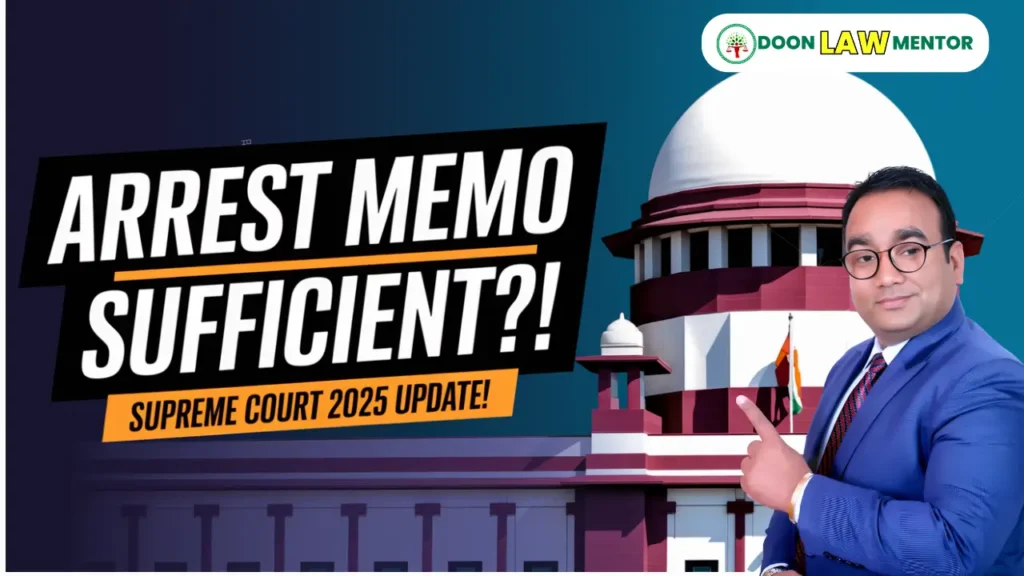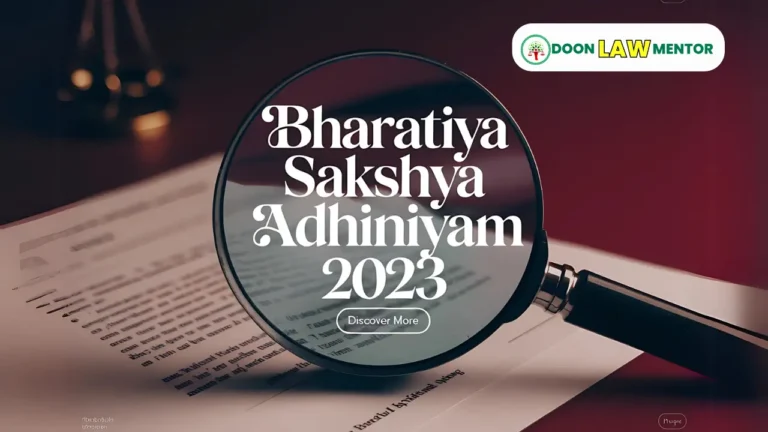In a landmark ruling in Ashish Kakkar v. UT of Chandigarh (2025 SC), the Supreme Court clarified that an arrest memo does not fulfill the requirement of supplying grounds of arrest under Section 47 of the Bharatiya Nagarik Suraksha Sanhita (BNSS) 2023, setting aside the arrest and remand of the appellant. Justices MM Sundresh and Rajesh Bindal emphasized that non-compliance with this constitutional mandate under Article 22(1) vitiates the arrest. This blog provides a detailed analysis of the arrest memo vs grounds of arrest debate, its legal implications, and its significance for Judiciary, APO, and JLO aspirants preparing for 2025 exams.
Table of Contents
Introduction
On March 30, 2025, the Supreme Court of India delivered a significant ruling in Ashish Kakkar v. UT of Chandigarh (2025 SC), setting aside the arrest and remand of the appellant due to non-compliance with Section 47 of the Bharatiya Nagarik Suraksha Sanhita (BNSS) 2023, which replaced the Code of Criminal Procedure (CrPC) 1973 on July 1, 2024. A bench comprising Justices MM Sundresh and Rajesh Bindal held that providing an arrest memo does not fulfill the mandatory requirement of supplying grounds of arrest in writing, a constitutional mandate under Article 22(1) of the Constitution of India. Building on the precedent set in Prabir Purkayastha v. State (2024), and drawing from landmark judgments like Joginder Kumar v. State of U.P. (1994) and D.K. Basu v. State of West Bengal (1997), the court emphasized that failure to communicate detailed grounds of arrest vitiates the arrest and subsequent remand. This blog provides a comprehensive analysis of the arrest memo vs grounds of arrest debate, the Ashish Kakkar case, its legal implications under the BNSS 2023, and its relevance for Judiciary, APO, and JLO aspirants preparing for 2025 exams.
Background of the Case: Ashish Kakkar v. UT of Chandigarh (2025 SC)
The Ashish Kakkar v. UT of Chandigarh case originated from the arrest of Ashish Kakkar in December 2024, in connection with a First Information Report (FIR) registered under Sections 318(4) (cheating), 319(2) (extortion), 336(3) (forgery for cheating), 339 (using forged documents), 352 (insult to modesty of a woman), and 61(2) (criminal conspiracy) of the Bharatiya Nyaya Sanhita (BNS) 2023, which replaced the Indian Penal Code (IPC) on July 1, 2024. The arrest was executed by the Chandigarh Police, and Kakkar was remanded to police custody for three days.
Initial Legal Challenge
- Arrest and Remand: Following his arrest, Kakkar was presented before a magistrate and remanded to police custody. The arrest memo provided to him contained only basic details, such as his name, the place of arrest, and a statement that he was arrested based on the statement of a co-accused. It lacked any specific grounds of arrest, such as the charges framed against him or the reasons necessitating his arrest.
- Challenge in Punjab and Haryana High Court: Kakkar challenged his arrest and remand before the Punjab and Haryana High Court, raising three grounds:
- Non-compliance with Section 35 of the BNSS 2023 (formerly Section 41A CrPC), which mandates a notice of appearance before arrest in certain cases.
- Denial of the opportunity to be heard at the time of remand.
- Non-furnishing of grounds of arrest, violating Section 47 BNSS 2023 (formerly Section 50 CrPC) and Article 22(1) of the Constitution.
The High Court, in its order dated January 30, 2025, refused to entertain Kakkar’s plea, prompting him to appeal to the Supreme Court.
Supreme Court Appeal
- Focus of the Appeal: Represented by Senior Advocate Siddharth Aggarwal, Kakkar’s appeal before the Supreme Court focused primarily on the non-furnishing of grounds of arrest, arguing that the arrest memo provided to him did not meet the legal requirements under Section 47 BNSS 2023 and Article 22(1). The respondent, UT of Chandigarh, was represented by Advocate Bhuvan Kapoor.
- Precedent Cited: The court relied heavily on its recent ruling in Prabir Purkayastha v. State (NCT of Delhi) (2024), which established that supplying grounds of arrest in writing is a mandatory requirement, and failure to comply vitiates the arrest and remand.
Key Findings of the Supreme Court in Ashish Kakkar v. UT of Chandigarh
The Supreme Court, in its judgment delivered on March 30, 2025, set aside Kakkar’s arrest and remand, focusing on the distinction between an arrest memo and grounds of arrest. The key findings are as follows:
1. Arrest Memo Does Not Constitute Grounds of Arrest
The court held that providing an arrest memo does not fulfill the legal requirement of supplying grounds of arrest under Section 47 BNSS 2023. The bench, comprising Justices MM Sundresh and Rajesh Bindal, observed:
“We are in agreement with the submission made by the learned senior counsel appearing for the appellant that the said arrest memo cannot be construed as grounds of arrest, as no other worthwhile particulars have been furnished to him.”
- Arrest Memo Details: The arrest memo provided to Kakkar only contained his name, the place of arrest, and a vague statement that he was arrested based on the statement of a co-accused. It lacked specific details, such as the charges framed, the nature of the allegations, or the reasons necessitating his arrest.
- Distinction from Grounds of Arrest: The court clarified that an arrest memo is a proforma document that records formal reasons for arrest, such as preventing further offenses or ensuring investigation, which are generic and apply to any arrest. In contrast, grounds of arrest must be specific to the individual, detailing the basic facts and allegations that justify their detention.
2. Non-Compliance with Section 47 BNSS 2023 and Article 22(1)
The court emphasized that Section 47 BNSS 2023 mandates that every person arrested without a warrant must be informed of the full particulars of the offense or the grounds of arrest. This provision gives effect to Article 22(1) of the Constitution of India, which guarantees that:
“No person who is arrested shall be detained in custody without being informed, as soon as may be, of the grounds for such arrest nor shall he be denied the right to consult, and to be defended by, a legal practitioner of his choice.”
- Violation of Constitutional Mandate: The court found that the failure to provide detailed grounds of arrest to Kakkar constituted a clear non-compliance with Section 47 BNSS 2023, thereby violating his fundamental right under Article 22(1).
- Consequence of Non-Compliance: Citing Prabir Purkayastha v. State (2024), the court held that such non-compliance vitiates the arrest and any subsequent remand, rendering them illegal and unconstitutional.
3. Reliance on Prabir Purkayastha Precedent
The Supreme Court relied on its earlier ruling in Prabir Purkayastha v. State (NCT of Delhi) (2024), which established that:
- The grounds of arrest must be communicated in writing to the arrestee, as a mandatory requirement under Article 22(1).
- Merely providing an arrest memo or orally reading the grounds does not suffice, as it fails to enable the arrestee to effectively challenge the arrest or seek bail.
- Failure to comply with this requirement invalidates the arrest and remand, as it deprives the arrestee of their fundamental right to be informed.
In Ashish Kakkar, the court applied this precedent, noting that the arrest memo provided to Kakkar lacked the necessary worthwhile particulars to constitute grounds of arrest, thus breaching the constitutional mandate.
4. Arrest Guidelines and Landmark Judgments
The court’s ruling in Ashish Kakkar aligns with established arrest guidelines laid down in landmark judgments like Joginder Kumar v. State of U.P. (1994) and D.K. Basu v. State of West Bengal (1997), which emphasize the protection of personal liberty during arrests:
- Joginder Kumar v. State of U.P. (1994): In this case, the Supreme Court held that an arrest cannot be made merely because it is lawful; there must be a justifiable reason for the arrest, and the police must balance the need for arrest with the individual’s right to liberty under Article 21. The court emphasized that the arrestee must be informed of the grounds of arrest to enable them to challenge the detention, a principle echoed in Ashish Kakkar where the lack of specific grounds violated Kakkar’s rights.
- D.K. Basu v. State of West Bengal (1997): This landmark judgment laid down guidelines to prevent custodial abuse, including the requirement that the arrestee be informed of the grounds of arrest in writing, as mandated by Article 22(1). The court also directed that an arrest memo be prepared, but clarified that it must include the reasons for arrest, a requirement the Chandigarh Police failed to meet in Ashish Kakkar. The D.K. Basu guidelines further mandate that the arrestee be produced before a magistrate within 24 hours, ensuring judicial oversight, which Kakkar was denied due to the lack of opportunity to be heard at remand.
The Ashish Kakkar ruling reinforces these guidelines, ensuring that the grounds of arrest are not just a formality but a substantive right that enables the arrestee to defend themselves, aligning with the principles of due process established in Joginder Kumar and D.K. Basu.
5. Setting Aside Arrest and Remand
Given the non-compliance with Section 47 BNSS 2023 and Article 22(1), the Supreme Court set aside:
- The arrest of Ashish Kakkar.
- The subsequent remand to police custody for three days.
- The impugned judgment of the Punjab and Haryana High Court dated January 30, 2025, which had upheld the arrest and remand.
The court did not delve into the other grounds raised by Kakkar (non-compliance with Section 35 BNSS 2023 and lack of opportunity to be heard at remand), as the non-furnishing of grounds of arrest was sufficient to vitiate the arrest.
Legal Implications of the Judgment
The Supreme Court’s ruling in Ashish Kakkar v. UT of Chandigarh (2025 SC) has far-reaching implications for arrest procedures, fundamental rights, and judicial oversight in India under the BNSS 2023:
1. Clarification of Arrest Memo vs Grounds of Arrest
The judgment clearly distinguishes between an arrest memo and grounds of arrest:
- An arrest memo is a procedural document that records basic details of the arrest, such as the name of the accused, place of arrest, and formal reasons (e.g., to prevent further offenses).
- Grounds of arrest, however, must include specific details of the allegations, charges, and reasons necessitating the arrest, tailored to the individual arrestee.
This distinction ensures that arrestees are not left in the dark about the reasons for their detention, enabling them to exercise their right to legal defense and challenge the arrest.
2. Reinforcement of Constitutional Safeguards
The ruling reinforces the constitutional mandate under Article 22(1), which guarantees that every arrestee must be informed of the grounds of arrest as soon as possible. This right is not a mere formality but a fundamental requirement to protect personal liberty under Article 21 (right to life and liberty). The court’s decision aligns with earlier precedents like:
- Prabir Purkayastha v. State (2024): Established that grounds of arrest must be provided in writing, and failure to do so invalidates the arrest.
- Vihaan Kumar v. State of Haryana (2025): Reaffirmed that non-compliance with Article 22(1) vitiates the arrest, emphasizing its status as a constitutional requirement.
- Joginder Kumar v. State of U.P. (1994): Highlighted the need for justifiable reasons for arrest, ensuring that the arrestee is informed of the grounds to challenge the detention.
- D.K. Basu v. State of West Bengal (1997): Mandated that the arrestee be informed of the grounds of arrest in writing, as part of broader guidelines to prevent custodial abuse.
3. Impact on Police Procedures Under BNSS 2023
The judgment imposes a stricter obligation on law enforcement agencies to:
- Provide written grounds of arrest to every arrestee, detailing the specific allegations and reasons for detention, as mandated by Section 47 BNSS 2023.
- Update arrest memo formats to include a column for grounds of arrest, as directed by the Delhi High Court in a related ruling on November 20, 2024, which ordered the Delhi Police to amend their arrest memo forms.
- Ensure compliance with Section 47 BNSS 2023, which mandates that the arrestee be informed of the full particulars of the offense or other grounds of arrest, aligning with the arrest guidelines in D.K. Basu and Joginder Kumar.
4. Protection Against Arbitrary Arrests
The ruling strengthens protections against arbitrary arrests by ensuring that arrestees are fully informed of the reasons for their detention. This enables them to:
- Challenge the arrest through legal remedies like a writ of habeas corpus.
- Oppose remand by presenting their defense before a magistrate, as emphasized in D.K. Basu.
- Seek bail if the offense is bailable or if the arrest is unlawful, a right protected under Joginder Kumar.
The decision aligns with the Supreme Court’s broader jurisprudence on curbing misuse of arrest powers, as seen in cases like Satender Kumar Antil v. CBI (2022), which issued directives to curb unnecessary arrests.
5. Judicial Oversight and Accountability
The judgment underscores the judiciary’s role in ensuring due process in arrests:
- Courts must scrutinize whether the grounds of arrest were properly communicated to the arrestee before upholding remand orders, a principle reinforced by D.K. Basu.
- Non-compliance with Section 47 BNSS 2023 or Article 22(1) renders the arrest and remand illegal, requiring courts to set them aside, as seen in Ashish Kakkar.
- The ruling also highlights the need for accountability in law enforcement, ensuring that police officers adhere to constitutional and statutory safeguards, as mandated in Joginder Kumar.
Critical Analysis: Balancing Police Powers and Fundamental Rights
The Ashish Kakkar v. UT of Chandigarh ruling is a significant step toward protecting fundamental rights, but it also raises several critical questions:
- Police Accountability: The decision exposes lapses in police procedures, as the arrest memo provided to Kakkar was inadequate. This reflects a broader issue of non-compliance with Section 47 BNSS 2023, as noted in posts on X, where users like @1Simranbakshi and @Prof_Dippak emphasized the distinction between an arrest memo and grounds of arrest. The Supreme Court’s ruling in Vihaan Kumar v. State of Haryana (2025) also highlighted similar violations, including inhumane treatment like chaining the arrestee to a hospital bed, indicating systemic issues in arrest practices.
- Implementation Challenges: While the court has clarified the law, ensuring compliance across India’s vast law enforcement system is a challenge. The Delhi High Court’s directive to update arrest memo forms is a step forward, but training police officers and standardizing procedures nationwide will require significant effort, as highlighted in D.K. Basu’s call for systemic reforms.
- Judicial Delays: Kakkar’s case took over a year to reach the Supreme Court after his arrest in December 2024, reflecting delays in the judicial process. While the court acted swiftly to set aside the arrest, the initial remand period caused undue hardship, underscoring the need for faster judicial intervention, as emphasized in Joginder Kumar.
- Balancing Police Powers: The ruling restricts arbitrary arrests, but some may argue it could hamper police investigations in urgent cases. However, the Supreme Court’s emphasis on written grounds, supported by D.K. Basu and Joginder Kumar, ensures that police powers are exercised within the bounds of due process, balancing public safety with individual rights.
The Ashish Kakkar judgment builds on a series of Supreme Court rulings in 2025, such as Vihaan Kumar v. State of Haryana and Prabir Purkayastha v. State, which have consistently reinforced the constitutional mandate of informing arrestees of their grounds of arrest. This trend reflects the judiciary’s commitment to curbing misuse of arrest powers and protecting personal liberty, a cornerstone of India’s democratic framework.
Relevance for Judiciary, APO, and JLO Aspirants
The Ashish Kakkar v. UT of Chandigarh (2025 SC) ruling on arrest memo vs grounds of arrest is a crucial topic for Judiciary, APO, and JLO aspirants preparing for 2025 exams:
- Prelims: Expect questions on the case name (Ashish Kakkar v. UT of Chandigarh), the legal provision (Section 47 BNSS 2023), the constitutional article (Article 22(1)), and the precedent cited (Prabir Purkayastha v. State).
- Mains: Write essays on topics like “Arrest Memo vs Grounds of Arrest: Balancing Police Powers and Fundamental Rights” or “Judicial Oversight in Arrest Procedures,” using this case to discuss Section 47 BNSS 2023, Article 22(1), and the Supreme Court’s role in protecting personal liberty, with references to Joginder Kumar and D.K. Basu. Analyze the implications of non-compliance on arrest validity.
- Interviews: Discuss the significance of the ruling in ensuring due process, the distinction between arrest memo and grounds of arrest, and the judiciary’s role in curbing arbitrary arrests, citing Ashish Kakkar, Prabir Purkayastha, Joginder Kumar, and D.K. Basu.
Conclusion
The Supreme Court’s ruling in Ashish Kakkar v. UT of Chandigarh (2025 SC) on March 30, 2025, marks a significant milestone in clarifying the distinction between an arrest memo and grounds of arrest, reinforcing the constitutional mandate under Article 22(1) and Section 47 BNSS 2023. By setting aside Kakkar’s arrest and remand due to non-compliance, the court has sent a strong message to law enforcement agencies about the importance of due process in arrests, building on precedents like Prabir Purkayastha v. State (2024), Joginder Kumar v. State of U.P. (1994), and D.K. Basu v. State of West Bengal (1997). The decision ensures that grounds of arrest must be specific, written, and communicated to the arrestee to enable them to defend their rights, protecting against arbitrary detentions. For Judiciary, APO, and JLO aspirants, understanding this case is essential for mastering arrest procedures, fundamental rights, and judicial oversight under the BNSS 2023, making it a key topic for 2025 exam preparation.
Call-to-Action
Stay updated on landmark rulings like Ashish Kakkar v. UT of Chandigarh for your 2025 exams! Join Doon Law Mentor’s Courses for expert guidance. Follow @doonlawmentor on Instagram for daily legal updates!
FAQs
- What did the Supreme Court rule in Ashish Kakkar v. UT of Chandigarh (2025 SC)?
The Supreme Court ruled that an arrest memo does not fulfill the requirement of supplying grounds of arrest under Section 47 BNSS 2023, setting aside the arrest and remand of Ashish Kakkar. - What is the difference between an arrest memo and grounds of arrest?
An arrest memo records basic details like the name and place of arrest, while grounds of arrest must include specific allegations and reasons for detention, tailored to the arrestee. - Why did the Supreme Court set aside Ashish Kakkar’s arrest?
The court found that the arrest memo lacked worthwhile particulars like charges, violating Section 47 BNSS 2023 and Article 22(1), making the arrest illegal. - What legal provision was violated in the Ashish Kakkar case?
The Chandigarh Police violated Section 47 BNSS 2023, which mandates informing the arrestee of the full particulars of the offense or grounds of arrest. - What constitutional article was cited in the Ashish Kakkar ruling?
The court cited Article 22(1), which guarantees that an arrestee must be informed of the grounds of arrest and cannot be denied the right to legal defense. - What precedent did the Supreme Court rely on in Ashish Kakkar v. UT of Chandigarh?
The court relied on Prabir Purkayastha v. State (2024), which held that grounds of arrest must be provided in writing, and non-compliance vitiates the arrest. - What sections of the BNS 2023 were involved in Ashish Kakkar’s arrest?
Kakkar was arrested under Sections 318(4), 319(2), 336(3), 339, 352, and 61(2) of the BNS 2023, replacing the IPC. - How long was Ashish Kakkar remanded to police custody?
Kakkar was remanded to police custody for three days following his arrest in December 2024. - What did Joginder Kumar v. State of U.P. (1994) establish about arrests?
Joginder Kumar held that arrests must be justifiable, and the arrestee must be informed of the grounds of arrest to challenge the detention, protecting personal liberty. - How does D.K. Basu v. State of West Bengal (1997) relate to Ashish Kakkar?
D.K. Basu mandated that grounds of arrest be provided in writing, a guideline violated in Ashish Kakkar, leading to the arrest being set aside.
#Doonlawmentor #SupremeCourt #AshishKakkarCase #ArrestMemo #GroundsofArrest #Article22 #Section50CrPC #bnss #JudiciaryExam2025 #LegalNews #LawStudents #ConstitutionalRights #DoonLawMentor #LegalUpdates #IndianLaw #CriminalLaw








